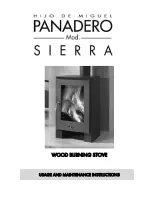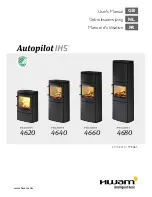
10
Fuel Caution
Do not burn trash (plastics and other trash emit harmful gases), driftwood, treated wood,
artificial logs, or non-seasoned wood.
Never use gasoline, gasoline-type lantern fuel, kerosene, charcoal lighter fluid,
naphtha, engine oil, or similar liquids to start or “freshen up” a fire in this heater.
Keep all such liquids well away from the heater while in use.
CARE AND MAINTENANCE
Although your RAIS stove requires little day-to-day upkeep, it is important to maintain it for
your safety and enjoyment.
IMPORTANT:
Y
OU SHOULD HAVE YOUR CHIMNEY AND STOVE CHECKED ONCE EVERY
2
MONTHS DURING THE
HEATING SEASON OR AT LEAST ONCE A YEAR BY A PROFESSIONAL CHIMNEY SWEEP AND CLEANED
AS NEEDED
.
Creosote – Formation and Need for Removal
When wood is burned slowly, it produces tar and other organic vapors, which combine with
expelled moisture to form creosote. The creosote vapors condense in the relatively cool
chimney flue of a slow-burning fire. As a result, creosote residue accumulates on the flue
lining. When ignited this creosote makes an extremely hot fire.
The chimney connector and chimney should be inspected once every two months during
the heating season to determine if a creosote buildup has occurred.
If creosote has accumulated it should be removed to reduce the risk of a chimney fire.
Surfaces
The outer surfaces can be wiped with a dry soft rag, and if needed, a small amount of mild
detergent, but try not to scrub!
Minor scratches and other surface damage can easily be touched up with the RAIS paint
supplied with each stove. Remove any dirt, tar, and rust, and make sure repairs are made
only when the stove is cool (room temperature).
Glass Doors
The glass can be easily cleaned by wiping with a damp rag dipped in some of the ashes. A
good commercial glass cleaner can also be used.






























